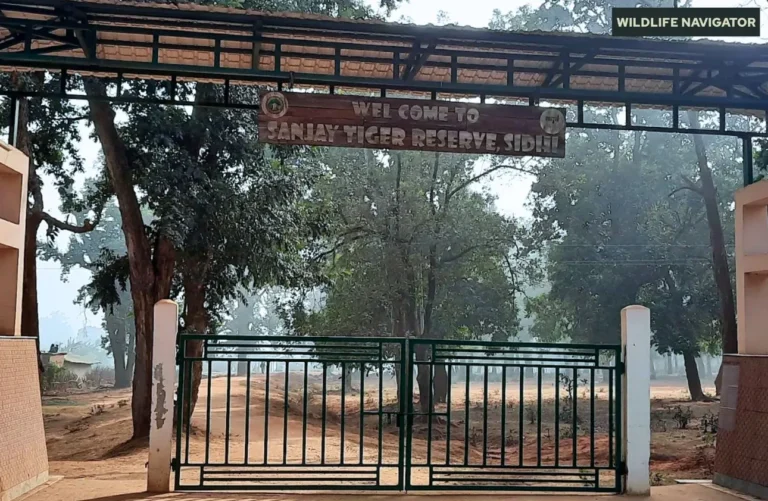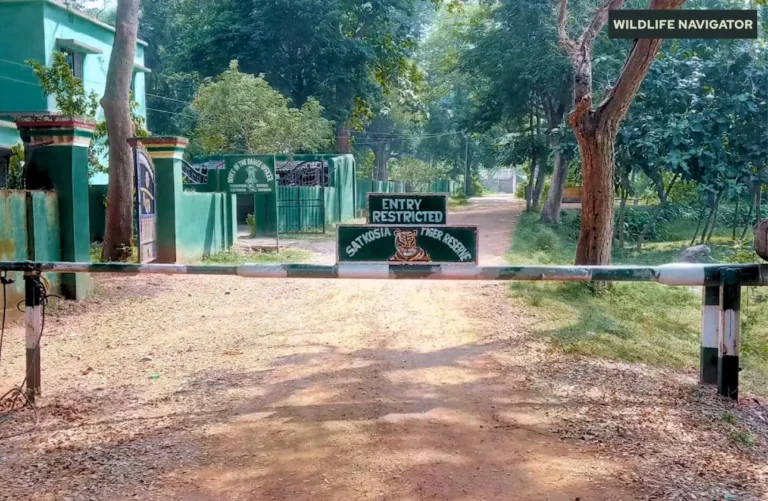Pilibhit Tiger Reserve: Safari Timings, Entry Fee, Best Time & Guide

Pilibhit Tiger Reserve is one of India’s most vibrant and biodiverse landscapes in the Terai region of Uttar Pradesh. Spread across more than 730 square kilometres, this reserve is a jewel of the Indo-Nepal border and a significant part of the Terai Arc Landscape, a globally important conservation region recognised for its tigers and other wildlife.
What makes Pilibhit unique is its blend of dense sal forests, lush grasslands, and river ecosystems fed by the Sharda and Ghaghara rivers. Unlike many other reserves in India, which are primarily dry deciduous or arid, Pilibhit offers a distinctive swampy and fertile environment that supports not just tigers, but also elephants, leopards, sloth bears, and an incredible variety of birdlife.
Declared a Tiger Reserve in 2014, Pilibhit is today home to over 65 tigers (as per recent estimates), making it one of the most successful conservation areas under India’s Project Tiger initiative. Beyond tigers, the reserve also harbours a rich avian population—over 300 bird species—including endangered vultures and migratory birds, making it a paradise for both wildlife enthusiasts and birdwatchers.
For travellers, Pilibhit Tiger Reserve offers an offbeat escape—less crowded compared to famous reserves like Jim Corbett or Ranthambore, yet equally thrilling in terms of safari experiences and raw wilderness. Whether you’re chasing the roar of a tiger, photographing rare birds, or simply immersing yourself in the unspoiled beauty of the Terai ecosystem, Pilibhit is a destination that promises authentic wilderness and soul-stirring experiences.
History, Geography & Landscape
History of Pilibhit Tiger Reserve
The story of Pilibhit Tiger Reserve is deeply tied to India’s commitment to wildlife conservation. Although the forests of Pilibhit were always known for their dense sal trees and abundant wildlife, they were originally managed as reserved forests under the British colonial administration. Hunting and timber extraction were once widespread, but the ecological importance of the area gradually gained recognition.
In 2008, the Uttar Pradesh government proposed Pilibhit as a Tiger Reserve, and by 2014, it officially earned the designation under Project Tiger. This was a major milestone for the Terai Arc Landscape (TAL)—a transboundary conservation initiative linking India and Nepal. Today, Pilibhit is one of the most successful tiger habitats, with rising tiger populations and significant conservation success stories.
Geography of Pilibhit Tiger Reserve
Pilibhit is situated in the northernmost region of Uttar Pradesh, along the India–Nepal border. It spans across the districts of Pilibhit, Shahjahanpur, Lakhimpur Kheri, and Bahraich, forming a critical corridor for tigers and elephants moving between India and Nepal.
- Total Area: ~730 sq. km (602 sq. km core + 127 sq. km buffer).
- Latitude & Longitude: Approximately between 28°6′ to 28°53′ N and 79°57′ to 80°27′ E.
- Altitude: 150 to 175 meters above sea level.
One of its most defining geographical features is its location in the Terai belt—a fertile lowland stretching along the Himalayan foothills. The Sharda River flows along the eastern boundary of the reserve, while several small rivulets and wetlands enrich the ecosystem.
Landscape of Pilibhit Tiger Reserve
The landscape of Pilibhit is a beautiful mosaic of forests, grasslands, and wetlands, offering diverse habitats for wildlife.
- Sal Forests: Dominated by Shorea robusta, these forests form the backbone of the reserve.
- Grasslands: Known locally as “Chaurs,” these open meadows provide grazing grounds for deer and excellent hunting grounds for tigers.
- River Ecosystems: The Sharda River, Devha, and Mala rivers not only enrich biodiversity but also support migratory birds.
- Swampy Areas & Wetlands: These marshes act as critical habitats for rare species like the swamp deer and large waterbirds.
The flat terrain interspersed with dense forests and open grasslands makes it an ideal environment for both herbivores and predators. The presence of the river ensures year-round water availability, which is one of the reasons why the tiger density in Pilibhit is relatively high compared to other reserves.
In 2020, Pilibhit Tiger Reserve was awarded the TX2 Award for doubling its tiger population in less than a decade—a recognition of its thriving landscape and successful conservation efforts.
Flora & Fauna of Pilibhit Tiger Reserve
One of the biggest charms of Pilibhit Tiger Reserve is its rich biodiversity, thanks to its Terai ecosystem. The mix of dense sal forests, grasslands, riverine tracts, and wetlands creates an environment that supports a wide variety of plants, mammals, birds, reptiles, and aquatic life.
Flora of Pilibhit Tiger Reserve
The forests here are predominantly moist deciduous and swampy, making them very different from the dry forests of central India.
- Dominant Trees:
- Sal (Shorea robusta): The lifeline of the forest, forming large stretches.
- Teak, Khair (Acacia catechu), Semal (Bombax ceiba), and Sissoo (Dalbergia sissoo).
- Bamboo clusters in some parts.
- Grasslands:
Pilibhit is dotted with “chaurs” (meadows), which serve as crucial grazing grounds for herbivores like deer and wild boar. - Wetlands & Swamps:
Rich in aquatic plants that provide food and shelter for fish, amphibians, and migratory birds.
Together, this vegetation supports an incredible food chain—from insects and herbivores to apex predators like the tiger.
Fauna of Pilibhit Tiger Reserve
Mammals
- Bengal Tiger (Panthera tigris tigris): The star attraction. Pilibhit is among the few reserves where tiger numbers are steadily increasing, with over 65+ tigers recorded.
- Leopard (Panthera pardus): Elusive and often found in fringe forest areas.
- Sloth Bear: Known for their shaggy coats and insect-eating habits.
- Herbivores:
- Spotted Deer (Chital)
- Sambar Deer
- Hog Deer
- Barking Deer
- Wild Boar
- Blue Bull (Nilgai)
- Other mammals: Rhesus Macaque, Langur, Jackal, and Civet.
Birds
Pilibhit is a birdwatcher’s paradise, with over 300 bird species recorded. Its wetlands and riverbanks attract both resident and migratory birds.
- Raptors: Crested Serpent Eagle, Changeable Hawk Eagle, and various vultures.
- Waterbirds: Woolly-necked Stork, Painted Stork, Black-necked Stork, Egrets, and Herons.
- Migratory Birds: Bar-headed Geese, Northern Pintail, and various ducks during winter.
- Endangered Species: The Himalayan Griffon Vulture and White-rumped Vulture are seen here, making it vital for vulture conservation.
Reptiles & Amphibians
- Mugger Crocodiles along rivers.
- Indian Rock Python and various non-venomous snakes.
- Turtles and amphibians thriving in wetlands.
Aquatic Life
The Sharda River and its tributaries support fish species that are vital for both wildlife and local fishing communities.
Safari Experience at Pilibhit Tiger Reserve
For most travellers, the real thrill of visiting Pilibhit lies in its safari experience—the chance to explore the untamed wilderness, track pugmarks, and maybe even spot the majestic Bengal tiger in its natural habitat. Unlike some of the more commercialised tiger reserves in India, Pilibhit offers a raw and less-crowded safari adventure, making it perfect for wildlife lovers who want an authentic jungle experience.
Safari Zones in Pilibhit Tiger Reserve
Pilibhit has multiple safari zones, each with a unique landscape and wildlife spotting opportunities:
- Madhotanda Zone – Famous for dense sal forests and good tiger sightings.
- Haripur Range – Rich in birdlife, wetlands, and grasslands; excellent for birdwatching.
- Mala Range – Known for its riverine habitats and high chances of spotting herbivores and big cats.
- Barahi Range – A mix of grasslands and swamps, often frequented by migratory birds and asian elephants.
Each zone offers different photographic and wildlife experiences, so many visitors try to book safaris in multiple zones.
Safari Types
- Jeep Safari: The most popular way to explore the reserve. Each jeep usually accommodates 6 tourists along with a guide and driver.
- Canter Safari: Larger vehicles (for groups), though less common here compared to big reserves like Corbett.
- Walking & Birding Trails (Restricted): Limited to certain areas under guided tours, especially for birdwatchers.
Safari Timings
Safaris are conducted twice daily:
- Morning Safari: ~6:00 AM to 9:30 AM (best for spotting tigers and active wildlife).
- Evening Safari: ~3:00 PM to 6:00 PM (ideal for birdwatching, elephants, and herbivores).
(Exact timings may vary slightly with seasons.)
Wildlife Sightings
- Tigers & Leopards: Best spotted in grasslands and near water sources, especially during summer.
- Deer & Wild Boar: Frequently sighted in open meadows.
- Birds: Morning safaris are magical for bird photography—wetlands attract storks, eagles, and migratory birds.
- Other Highlights: Occasional elephant herds moving across the Terai corridor.
Photography Opportunities
For wildlife photographers, Pilibhit is a dream:
- Golden sunlight filtering through sal forests.
- Tigers in tall Terai grasslands—giving that classic wild India look.
- Vibrant birdlife on riverbanks.
- Misty mornings in winter, ideal for atmospheric shots.
Why Pilibhit Safari Feels Special
Unlike tourist-heavy reserves, Pilibhit’s safaris are relatively peaceful and intimate. You often feel like you’re the only jeep in the jungle, listening to alarm calls, rustling grass, and the occasional roar that echoes across the forest. It’s this rawness that makes Pilibhit stand out.
Entry Fee, Safari Timings & Booking Information
Before planning your trip to Pilibhit Tiger Reserve, it’s important to know about entry fees, safari timings, and booking rules. Since it’s a relatively less-crowded reserve compared to places like Corbett or Ranthambore, the booking process is smoother—but availability can still be limited during peak seasons.
Entry Fee (Approximate Charges)
(Note: Fees may vary season to season; always check the official site or forest department before visiting.)
- Indian Nationals (Adults): ₹150–₹200 per person
- Foreign Nationals: ₹400–₹600 per person
- Children (Below 6 years): Free entry
- Still Camera: ₹50–₹100
- Video Camera / DSLR with long lenses: ₹200–₹500 (varies)
Safari Vehicle Charges
- Jeep Safari (6-seater): ₹2,000–₹2,500 per vehicle per ride (includes driver + guide, but excludes entry tickets).
- Canter Safari (20-seater): ₹300–₹500 per person (less common here).
- Guide Charges: ₹300–₹500 per safari (mandatory).
Most visitors book a jeep safari package, which covers entry, guide, and vehicle fees.
Safari Timings
Safaris are conducted twice a day, and timings differ by season:
- Summer (March–June):
- Morning Safari: 5:30 AM – 9:00 AM
- Evening Safari: 3:30 PM – 6:30 PM
- Winter (October–February):
- Morning Safari: 6:30 AM – 10:00 AM
- Evening Safari: 2:30 PM – 5:30 PM
(Safari timings may slightly change depending on sunrise and sunset hours.)
Safari Booking Information
- Online Booking:
- Official UP Forest Department website or authorised portals.
- Visitors must provide ID proof (Aadhaar, Passport, etc.) at the time of booking.
- Bookings open 45–60 days in advance.
- Offline Booking:
- Available at forest entry gates like Madhotanda, Haripur, or Barahi.
- Subject to availability, so weekends and holidays may be risky for walk-ins.
- What You Need to Book:
- Full name, age, gender, and ID details of all travellers.
- Preferred safari date and zone.
- Payment (online/offline).
Important Rules & Guidelines
- Carry the original ID proof used during booking.
- Entry is allowed only with an authorised guide.
- Do not get out of vehicles during the safari.
- Avoid plastic, loud noise, and feeding animals.
Best Time to Visit Pilibhit Tiger Reserve
Choosing the right season is crucial for an enjoyable wildlife experience. Since Pilibhit is part of the Terai belt, its climate is quite different from central or southern India’s tiger reserves. It has humid summers, heavy monsoons, and misty winters, each offering a unique experience for visitors.
Seasons at Pilibhit Tiger Reserve
Summer (March – June)
- Temperature: 28°C to 42°C
- Experience: Summers can be hot and humid, but they are the best time for tiger sightings. Animals frequently visit waterholes and rivers, making them easier to spot.
- Photography: Excellent for capturing tigers in tall grass under golden sunlight.
- Travel Tip: Carry hats, sunscreen, and plenty of water. Morning safaris are more comfortable.
Monsoon (July – September)
- Temperature: 25°C to 35°C
- Experience: The reserve receives heavy rainfall during the monsoon. The forest turns lush green, rivers swell, and wetlands overflow. However, safaris remain closed during peak monsoon (July to September) for safety and to allow the forest to rejuvenate.
- Photography: Misty rivers and rain-washed forests look magical, but safari access is restricted.
- Travel Tip: Avoid this period for safaris; you can still explore nearby villages and landscapes.
Winter (October – February)
- Temperature: 8°C to 20°C
- Experience: Winters are pleasant and most comfortable for safaris. The misty mornings create a mystical jungle atmosphere, making this the most popular season for tourists.
- Birdwatching: Best time to see migratory birds from Central Asia and Europe, including Bar-headed Geese, Northern Pintail, and storks.
- Travel Tip: Pack woollens and enjoy both safaris and birdwatching walks.
Ideal Time for Wildlife Lovers
- For Tigers & Big Cats: March – June (summer).
- For Birdwatchers: November – February (winter).
- For Pleasant Travel Experience: October – March.
Park Opening & Closing Months
- Open Season: Mid-October to June.
- Closed Season: July to September (monsoon).
How to Reach Pilibhit Tiger Reserve
Pilibhit Tiger Reserve is located in the northern part of Uttar Pradesh, along the Indo-Nepal border. Despite being relatively less famous than Corbett or Dudhwa, it is well connected by road, rail, and air, making it accessible for both domestic and international travellers.
By Air
- Pantnagar Airport (PGH): ~110 km away, the nearest airport with limited domestic flights.
- Bareilly Airport (BEK): ~65 km away, now operational for regional flights.
- Lucknow Airport (LKO): ~270 km away, a major international airport with better connectivity.
- Delhi Airport (DEL): ~300 km away, best option for international tourists.
From these airports, you can hire a taxi or take a bus/train to reach Pilibhit.
By Train
The reserve is well connected through Pilibhit Junction Railway Station, located ~10 km from the reserve entry.
- Regular trains run from Delhi, Lucknow, Bareilly, and Tanakpur.
- Popular options include Intercity Express, Bareilly–Pilibhit trains, and other regional connections.
- From the railway station, you can easily hire an auto, cab, or local transport.
By Road
Pilibhit has decent road connectivity with major cities in Uttar Pradesh and neighbouring states.
- From Delhi: ~300 km (6–7 hours via NH9).
- From Bareilly: ~55 km (1.5 hours).
- From Lucknow: ~270 km (6 hours).
- From Nainital: ~130 km (3–4 hours).
State transport buses and private taxis are easily available, but for safari travellers, hiring a private cab is recommended for flexibility.
Distance Chart (Approximate)
- Bareilly → Pilibhit: 55 km
- Lucknow → Pilibhit: 270 km
- Delhi → Pilibhit: 300 km
- Nainital → Pilibhit: 130 km
Local Transport
Once you reach Pilibhit town, the best way to explore the reserve is by booking jeep safaris. Auto-rickshaws and shared cabs operate in the town, but they’re not suitable for forest entry.
Accommodation Options Near Pilibhit Tiger Reserve
Pilibhit Tiger Reserve is still an offbeat destination, so it doesn’t have luxury lodges like Corbett or Ranthambore. However, visitors will find a mix of forest rest houses, eco-huts, and budget-friendly hotels in and around the reserve. These stays provide a close-to-nature experience, often surrounded by lush greenery and village charm.
Forest Rest Houses (FRH)
The Forest Department operates rest houses inside and near the reserve. Staying here gives you the closest jungle experience with basic facilities.
- Barahi Forest Rest House – Located near entry points, convenient for early safaris.
- Mala Forest Rest House – Surrounded by sal forests, ideal for birdwatchers.
- Haripur Rest House – Close to wetlands, peaceful and scenic.
Bookings are done through the UP Forest Department office or official website. Facilities are simple—don’t expect luxury, but it’s perfect for wildlife lovers.
Eco Huts & Cottages
Some eco-tourism accommodations run by the Forest Department and local communities offer rustic huts and cottages with a natural feel. These are great for travellers who want to support sustainable tourism while staying close to nature.
Hotels & Resorts in Pilibhit Town
If you prefer more comfort, you can stay in Pilibhit town (10–15 km from the reserve) or nearby areas:
- Budget Hotels: Small lodges and guesthouses starting from ₹800–₹1,500 per night.
- Mid-range Hotels: Comfortable stays with AC rooms and basic amenities, ranging from ₹2,000–₹3,500 per night.
- Nearby Resorts: A few private resorts and farm stays have recently come up on the outskirts, offering jeep safari packages.
Staying in Bareilly or Nainital
For travellers who want more facilities, Bareilly (55 km) and Nainital (130 km) have better hotels, including luxury chains. You can stay there and make a day trip to Pilibhit, though staying near the reserve is more convenient for safaris.
Accommodation Tips
- Always book forest rest houses in advance—limited availability.
- Carry your own essentials (toiletries, snacks, mosquito repellent).
- For early morning safaris, stay as close to the reserve as possible.
- Eco-huts are best for those seeking authentic nature vibes; hotels are better for families seeking comfort.
Pilibhit is not about luxury—it’s about immersing yourself in wilderness. Whether you choose a forest rest house in the middle of the jungle or a budget-friendly lodge in town, the real reward is waking up to the sound of birds and heading out for an early morning safari.
Travel Tips for Pilibhit Tiger Reserve
Visiting a tiger reserve is an unforgettable experience, but it also requires some preparation and awareness. Pilibhit, being a relatively offbeat destination, offers a more raw jungle experience, so keeping these tips in mind will help you enjoy your trip while staying safe and responsible.
Essential Travel Tips
Rules & Regulations
- Always carry the original ID proof used for safari booking.
- Entry is only allowed with an authorised forest guide.
- Do not get off the safari vehicle inside the reserve.
- Avoid loud noises, music, or shouting—silence increases your chance of spotting wildlife.
- Littering and carrying plastic inside the reserve is strictly prohibited.
What to Pack
- Clothing: Neutral-colored clothes (olive, brown, beige, green) to blend with the forest. Avoid bright colours.
- Seasonal Gear:
- Winters – Woollens, mufflers, gloves for chilly morning safaris.
- Summers – Light cottons, caps, sunglasses, and sunscreen.
- Footwear: Comfortable sports shoes or trekking shoes.
- Accessories:
- Binoculars (for birdwatching).
- Camera with zoom lens (optional).
- Reusable water bottle and light snacks.
- Insect repellent (especially in monsoon and post-monsoon).
Safari Tips
- Book safaris well in advance (at least 30–45 days ahead in peak season).
- Morning safaris have higher chances of big cat sightings.
- Listen to your guide’s instructions—local guides have an excellent eye for tracking animals.
- Don’t get disappointed if you don’t spot a tiger—enjoy the forest, deer herds, birdlife, and the overall wilderness experience.
Responsible Tourism
- Respect wildlife and their space. Maintain distance while photographing.
- Support local communities by choosing eco-lodges and buying local products.
- Avoid single-use plastic; carry reusable bottles and bags.
- Do not feed animals or throw food waste inside the forest.
Health & Safety
- Carry basic medicines and a first-aid kit.
- Stay hydrated, especially in summer safaris.
- Mobile networks may be weak inside the reserve—inform someone about your safari schedule in advance.
Pilibhit is less commercialised compared to other reserves—embrace the simplicity, stay flexible with your plans, and let the jungle surprise you. Sometimes the alarm call of a langur, or the sight of migratory geese taking off from a wetland, can be as magical as spotting a tiger.
Conclusion
The Pilibhit Tiger Reserve may not yet enjoy the fame of Corbett or Ranthambore, but that’s exactly what makes it special. It’s a place where the wilderness still feels untouched, where you can hear the call of a peacock echoing across grasslands, where misty mornings reveal flocks of migratory birds, and where the tiger still roams free in tall Terai grasses.
For wildlife lovers, photographers, birdwatchers, and eco-travellers, Pilibhit offers something unique—a chance to experience the raw charm of the Terai ecosystem without the overwhelming crowds of bigger reserves. Its growing tiger population, diverse flora and fauna, and tranquil landscapes make it one of India’s most promising wildlife destinations.
A trip here isn’t just about ticking “tiger sighting” off your list—it’s about immersing yourself in a living ecosystem, supporting conservation, and reconnecting with nature. Whether you stay in a simple forest rest house, wake up to the calls of parakeets, or venture out on an early morning safari with fog swirling around, Pilibhit promises memories that linger long after you leave.
So, if you’re planning your next wildlife adventure, step off the beaten track and choose Pilibhit Tiger Reserve. Here, the forests are alive, the rivers sing, and every corner whispers the wild secrets of the Terai.





